
German postcard by Ross Verlag, no. 1766/2, 1927-1928. Rudolph Valentino in A Sainted Devil (Joseph Henabery, 1924).
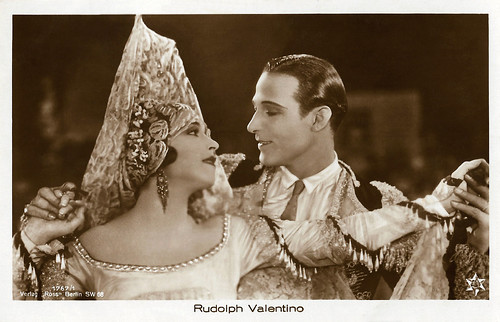
German postcard by Ross Verlag, no. 1767/1, 1927-1928. Photo Stern Film Verleih. Rudolph Valentino and Helena D'Algy in the American silent film A Sainted Devil (Joseph Henabery, 1924).
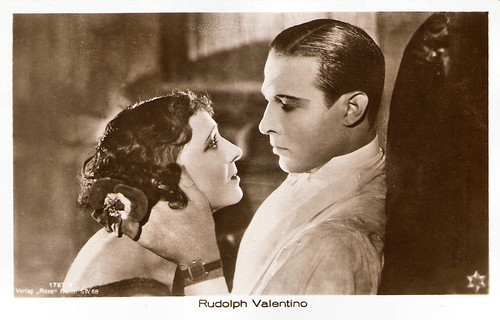
German postcard for Ross Verlag, Berlin, no. 1767/2, 1927-1928. Photo: Famous Players-Lasky Corporation. Rudolph Valentino and Louise Lagrange in A Sainted Devil (Joseph Henabery, 1924).

German postcard by Ross Verlag, no. 1767/3, 1927-1928. Photo Stern Film Verleih. Rudolph Valentino and Helena D'Algy in the American silent film A Sainted Devil (Joseph Henabery, 1924).
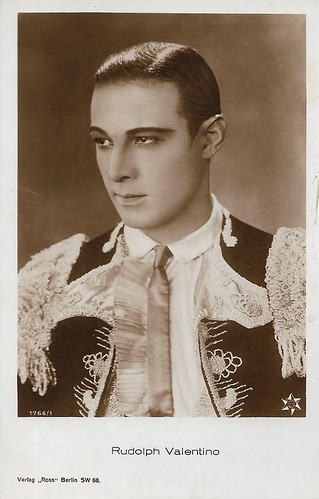
German postcard by Verlag Ross, Berlin, no. 1766/1. Photo: Stern Film Verleih. Rudolph Valentino in A Sainted Devil (Joseph Henabery, 1924). The back of the card has writings in French. In France, the film was released as L'hacienda rouge.
Kidnapped on her wedding night
In accordance with custom, Castro arranges the marriage of his son, Don Alonzo de Castro, an attractive Latino grandee from old Spanish nobility (Rudolph Valentino), with Julietta (Helena or Helen D'Algy), a beautiful and lovely Argentinean woman he has never met before. She comes to the South American state for the wedding.
The lavish party is to be celebrated at de Castro's sprawling hacienda. But Alonzo has not reckoned with his ex, the fiery and hot-blooded Carlotta (Nita Naldi). The daughter of the majordomo is jealous. With her father, she teams up with El Tigre (George Siegmann), the notorious Bandido leader who has been making the area unsafe for some time. When he and his gang raid the wedding feast, the villain's sole target is the bride. A fierce fight ensues, but the nobleman is defeated and cannot prevent Julietta from being kidnapped.
Don Alonzo immediately chases after the criminals and is able to confront them in their camp, which they have set up in a ruined church. From his hiding place, the robbed groom witnesses a woman in wedding clothes embracing and kissing El Tigre. Alonzo automatically believes that this can only be his Julietta.
From now on, Alonzo and El Tigre are mortal enemies, and after another encounter, in which Don Alonzo manages to escape in an adventurous manner, the Spanish nobleman swears eternal revenge. However, Alonzo has also lost his faith in his newly wedded wife, Julietta. He cannot make sense of why this chaste girl, who was educated in a convent, throws herself so shamelessly at the neck of a proven villain. The landowner has no idea that what he really saw was Carlotta, the mastermind of this plot, throwing herself into Julietta's wedding dress and embracing the chief villain.
While Alonzo increasingly focuses all his senses on stopping El Tigre, Julietta manages to free herself a little later with the help of the dancer Carmelita (Louise Lagrange). The bride finds shelter in a women's convent, where she is protected from El Tigre's persecution for the time being. But Don Alonzo knows nothing of these events. More and more he threatens to mutate into an avenging angel and drunkard, unable to get over the loss of his own wife and her supposed love affair with El Tigre: a holy devil, as the film title suggests.
When Don Alonzo learns that El Tigre is supposed to be in a sinister, ill-reputed pub, the Spanish grandee seeks direct confrontation with the chief scoundrel. Here it comes to a showdown. When Alonzo enters the tavern and sees El Tigre coming down the stairs, he jumps on him without warning and is about to strangle the bandit chief. Carlotta, who is also present, lets out a sharp cry, and the groom also has to realise that a dead villain cannot tell him the whereabouts of his wife.
El Tigre uses the upper hand he thinks he has gained and is about to kill Don Alonzo when the 'haciendero' receives unexpected help from Don Luis (Antonio a.k.a. Tony D'Algy). The latter is a mortal enemy of El Tigre and cuts down the chief villain. Now Don Alonzo also learns that it was actually Carlotta who embraced and kissed El Tigre in the bandit camp. Although Carmelita, the escape helper, is in love with Don Alonzo herself, she finally reveals to him the whereabouts of his newlyweds, so that the young couple can finally embrace again and can start a new life together.

Swedish postcard by Förlag Nordisk Konst, Stockholm, no. 1324. Rudolph Valentino in A Sainted Devil (Joseph Henabery, 1924).

Italian postcard by Ed. Ballerini & Fratini, Florence, no. 428. Photo: Films Paramount. Rudolph Valentino in A Sainted Devil (Joseph Henabery, 1924).

Italian postcard by Ed. Ballerini & Fratini, Florence, no. 429. Photo: Films Paramount. Rudolph Valentino and Nita Naldi in A Sainted Devil (Joseph Henabery, 1924). The Italian title Notte nuziale translates as Wedding Night.
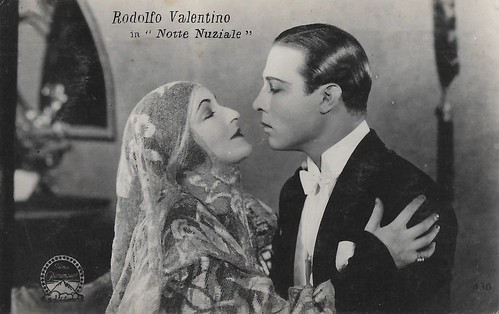
Italian postcard by Ed. Ballerini & Fratini, Florence, no. 430. Photo: Films Paramount. Rudolph Valentino and Dagmar Godowsky in A Sainted Devil (Joseph Henabery, 1924).
A splendid portrayal of a man seeing red
A Sainted Devil (1924) was directed by Joseph Henabery and produced by Adolph Zukor and Jesse Lasky. The film was made in the spring and summer of 1924 in Farmingdale on Long Island and at Paramount Studios in Astoria, New York City. The story was based on the novel 'Rope's End' by Rex Beach and adapted by Forrest Halsey. During the production, Dagmar Godowsky replaced Jetta Goudal, who repeatedly clashed with Valentino's wife, Natacha Rambova. Bebe Daniels was even replaced by Nita Naldi before filming began. As he did in Four Horsemen of the Apocalypse, Valentino plays an Argentine with a talent for the tango. The production and costuming are elaborate
The premiere took place on 17 November 1924. A week after the premiere, Mordaunt Hall wrote in The New York Times: "The narrative is told with a certain deliberation, the same tempo being sustained for its full length. There are times, however, when subtitles cover action which it would have been better to include as scenes. Then in several instances, one does not receive a clear idea of the passage of time, and here and there one perceives scenes which are introduced with tranquil poses.
Joseph Henabery, who directed this picture, has lost no little time by the inclusion of many close-ups, some of which are mere poses with little expression. Mr. Valentino is, however, a far better actor in this film than in Monsieur Beaucaire. The atmosphere evidently suits him. Toward the end of the film, he flings aside all thoughts of good looks and soft smiles and gives a splendid portrayal of a man seeing red. His rage in this sequence is most impressive, as it comes as a marked contrast to his calm bearing throughout most of the other stretches. (…) There are several fine settings in this production, and that of the hacienda is remarkably well reproduced. There is a lavish set of a cabaret, which is introduced to show the fast life Don Alanzo is leading."
However, Photoplay wrote in its review that the film "lacks force, as well as the charm of Monsieur Beaucaire. There are several reasons. Rex Beach's romance has been clumsily told and Rudy himself isn't real in his stressed emotional moments," concluding with "the story gets involved in inessentials and misses anything like a big sensation." And finally, Paimann’s Filmlisten notes: "The title, however, is interesting, but not properly chosen for the feuilletonistic but crowd-pleasing subject. In the consistently good acting, Valentino and the Naldi stand out, just as the photography achieves good effects. The presentation is picturesque and thoroughly creditable"
The same team behind A Sainted Devil (1924) - Adolph Zukor, Jesse Lasky, Joseph Henabery, cinematographer Harry Fischbeck, Rudolph Valentino, Nita Naldi) made the film Cobra immediately afterwards, but it was to prove far less successful than this production. With no prints of A Sainted Devil located in any film archives, it is considered now a lost film.

Italian postcard by Ed. Ballerini & Fratini, Florence, no. 431. Photo: Films Paramount. Rudolph Valentino and Helena d'Algy in A Sainted Devil (Joseph Henabery, 1924).
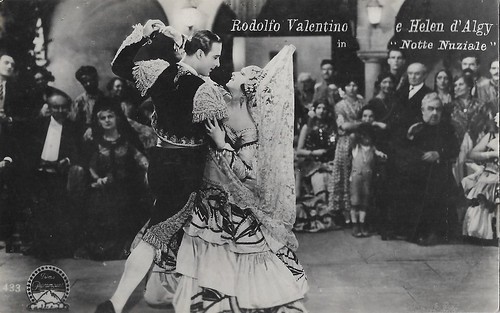
Italian postcard by Ed. Ballerini & Fratini, Florence, no. 433. Photo: Films Paramount. Rudolph Valentino and Helena d'Algy in A Sainted Devil (Joseph Henabery, 1924).

Italian postcard by Ed. Ballerini & Fratini, Florence, no. 435. Photo: Films Paramount. Rudolph Valentino and Helena d'Algy in A Sainted Devil (Joseph Henabery, 1924).
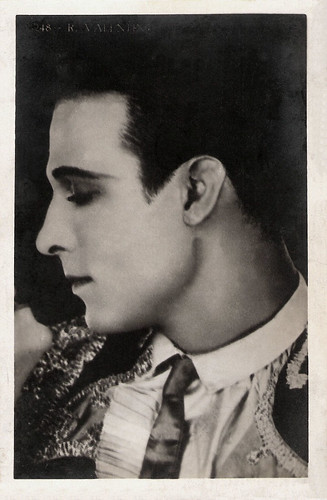
Italian postcard, no. 48. Photo: Rudolph Valentino in A Sainted Devil (Joseph Henabery, 1924).

Austrian postcard by Iris Verlag, no. 651/1. Photo: Paramount-Film. Rudolph Valentino in A Sainted Devil (Joseph Henabery, 1924).
Sources: Janiss Garza (AllMovie), Wikipedia (German and English), and IMDb.
No comments:
Post a Comment